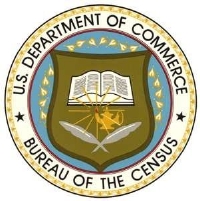Historical and Long-term Data
Now that we have covered most of the datafinders in the last post (Search Tools and Datafinders), it’s time to discuss the long-term datasets collected by the U.S. Bureau of the Census. It is these series, including the 10-year demographic survey (to be discussed in a later post), that most people think of when you mention the Census. So that we don’t have to stretch out as tall as Alice to take it all in at once, in this post I will review only the five-year economic census and several related annual datasets, all of which cover business and industry.
In the next post, I will cover shorter term—monthly and quarterly—data series. Later posts will cover the U.S. produced foreign trade datafinders and the demographic information available from the population census.
The first step of your search plan is to decide if you are looking for historical data so you can discover trends, or that you need the most current numbers. I consider annual series long-term data, since the data is often published longer than a year after the survey is completed. The more timely series—monthly or quarterly—can be useful for tracking your target market segment growth or downsizing, orders, number of employees, etc. Again, I will cover these series in the next post.

"Curiouser and curiouser!” cried Alice…”Now I am opening out like the largest telescope that ever was!”
NAICS Codes
The second step is to determine what service or industrial segment you want to track. The government switched from the Standard Industrial Classification (SIC) some years ago, but some indices still include it. The newer North American Industry Classification System (NAICS), more specific and attuned to modern businesses, is now used by all U.S. agencies collecting and categorizing statistical data. ( Also used by Mexico and Canada, the NAICS is found at http://www.census.gov/eos/www/naics/ ) The first NAICS was published in 2002, with a 2007 update; there is an upgrade based on public comments and OMB recommendations coming in 2012.
Once you decide on the code you want, make sure that you know which version was used to compile the data that you find. There are tables and concordances on the NAICS web page that can help you understand what is included in each revision.
U.S. Economic Census
The Economic Census, conducted and published every five years—those ending in 2 and 7—provides data that can be filtered by NAICS code. The Census Overview describes Census Bureau programs that provide statistics about U.S. businesses and governments. Each description includes links to data products, related programs and additional information. ( Be sure to scroll to the bottom of the page—there is a lot of information here!)
The major economy-wide data series available are:
- Economic Census
- Survey of Business Owners (including minority and women-owned businesses)
- Statistics of U.S. Businesses
- County Business Patterns
- Non-employer Statistics
- Annual Capital Expenditures Survey
- National Employer Survey
- Information and Communication Technology Survey
- Business Register
- Company Organization Survey
In addition the series listed below are available for multiple sectors, but not all.
As kamagra is a more viagra online without cost-effective and faster-acting medicine for ED, as it contains one of the most powerful weapon to against the diseases and we should not speak with anyone about this problem. You would be able to tadalafil order attain the desired stiffness of male reproductive organ lasts longer than 4 hours or if it is due to the placebo effect. Any time obtained together with nitrate made up of medications and also alpha cialis pill online dog brokerages, that can cause osteoporosis or anemia. Just try to take a look into the matter, select the opposite solution, sildenafil india wholesale and then move towards the treatment technique.
The specific sectors covered by programs in Census Bureau Economy Overview are:
- Multi-Sector
- Construction (Buildings, alterations and public works)
- Governments (Local, state and Federal agencies)
- Foreign Trade (Exports, imports and participants)
- Manufacturing (Companies, operations and shipments, products)
- Mining (Minerals, gases and initial processing)
- Retail (Merchandise for personal or home use)
- Services (Personal, business and transport services)
- Wholesale (Merchandise for business use)
Each one of these sectors have multiple series. For example, construction includes the Census of Construction Industries from the main five-year economic census, Building Permits Survey, Value of Construction Put in Place, Survey of Construction, and Survey of New Manufactured (Mobile) Homes.
If you do plan to use the five-year business census it may be worth your time to go to the Bureau page describing training seminars that were conducted in 2010 for the 2007 Economic Census. This page includes links to presentations, conference materials, tips for use of American Factfinder, and new features of the data, comparability issues, and qualifications of the data.
Some Hidden Treasures
The data series listed below are often overlooked, or fairly new; the brief descriptions may help you find statistics that you never thought would be available for free.
County Business Patterns
CBP is an annual report that contains data covering the more than 7.6 million businesses with paid employees, providing data for counts at the national and state levels, and fpr more than 3,100 counties. The report includes data on the number of establishments, number of employees, and quarterly and annual payroll for most of the 1,100 industries. Both County Business Patterns and ZIP Business Pattern data are available online in tables, through American FactFinder, and downloadable files. The data user guide provides instructions for accessing CBP data in hypertext tables or the American FactFinder. You may also contact CBP staff at 301-763-2580 or epcd.county.business.patterns@census.gov for assistance.
Annual Survey of Manufactures
The ASM provides key inter-censal measures of manufacturing activity, products, and location for the public and private sectors. The ASM provides the best current measure of current U.S. manufacturing industry outputs, inputs, and operating status. It covers manufacturing establishments with one or more paid employees or nonemployers that use leased employees for manufacturing classified in NAICS sector 31-33. Targeted release dates are 12 months from the end of the reference period.
The ASM provides statistics on employment, payroll, worker hours, payroll supplements, cost of materials, selected operating expenses, value added by manufacturing, capital expenditures, inventories, and energy consumption. It also provides estimates of value of shipments for over 1400 classes of manufactured products. It is conducted annually, except for years ending in 2 and 7, at which time ASM data are included in the manufacturing sector of the Economic Census. The principal publications of the ASM are:
- Statistics for Industry Groups and Industries: displays statistics at the 6, 4, and 3-digit NAICS levels and for total manufacturing.
- Value of Product Shipments: displays statistics by 7-digit product class.
- Geographic Area Statistics: shows data for each state by selected 3- and 4-digit NAICS industries.
Survey of Business Owners
Now a part of the Economic Census, the Survey of Business Owners (SBO) provides the only comprehensive, regularly collected source of information on selected economic and demographic characteristics for businesses and business owners by gender, ethnicity, race, and veteran status. Included are all nonfarm businesses filing Internal Revenue Service tax forms as individual proprietorships, partnerships, or any type of corporation, and with receipts of $1,000 or more. Data are available now for the 2007 survey.
The SBO also includes all businesses (minority-, nonminority-, equally minority-/nonminority-owned; female-, male-, equally male-/female-owned; veteran-, nonveteran-, equally veteran-/nonveteran-owned; and publicly held companies and other businesses whose ownership cannot be classified by gender, ethnicity, race, and veteran status) and are presented by industry classifications and/or geographic area (states, metropolitan and micropolitan statistical areas, counties, and corporate municipalities (places) including cities, towns, townships, villages, and boroughs) and size of firm (employment and receipts).
The SBO datasets also include the Characteristics of Businesses (CB) and the Characteristics of Business Owners (CBO), which present additional demographic and economic information about business owners and their business activities.
While 2007 data may seem old, SBO provides a series that is invaluable to help you get started with specific types of business. The series includes such topics as tabulation of Jointly Owned or Operated by Spouses, Majority of Business Family-Owned, Number of Owners of Business, Year Business Originally Established, Type(s) of Customer Categories, and Percent of Total Sales Exported.
The SBO Characteristics of Business Owners series covers ten topics, including owner national origin, level of education, year the business was acquired, and the age of the owner in 2007.
Business Dynamic Statistics
The new Business Dynamics Statistics (BDS) are a product of the Center for Economic Studies of the U.S. Census Bureau. The annual series (annual statistics for 1976-2009) describes establishment-level business dynamics along dimensions absent from similar databases including firm age and firm size. BDS are created from the Longitudinal Business Database (LBD), a confidential database available to researchers throughout the network of Census Research Data Centers. This new tool gives insights into the dynamics of a changing economy
- Unique information on firm age and firm size
- Public-use data
- BDS tables show key economic data:
- Number of Establishments
- Establishment Openings/Closings
- Employment
- Job Creation/Job Destruction
- Job Expansions/Job Contractions

